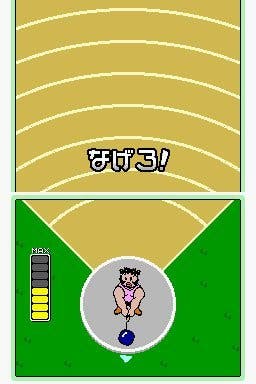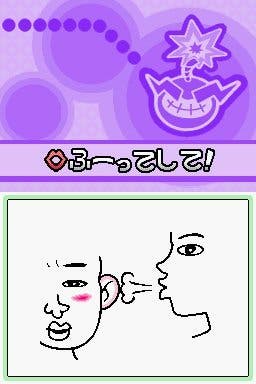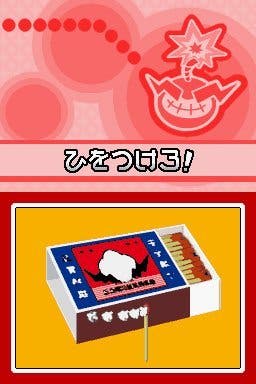Wario Ware Touched!
The Nintendo DS's first killer app?
As we reported just before Christmas, certain combinations of Nintendo DS units and Wario Ware Touched!, Nintendo's latest mixture of quick-fire "microgames", are troubled by a couple of frustrating bugs that make it more or less impossible to complete several key tasks successfully. We still don't know why, either because Nintendo hasn't actually clarified the situation in Japan or because the various websites that diligently translate reports from the company's homeland haven't gotten round to conveying an explanation, but we can at least say we have proof the problems exist. Because we're suffering from them ourselves.
But more on that in a bit. (We're just trying to sucker you in.)
Touchy feely

Much like its Game Boy Advance forerunners Wario Ware, Inc. and Wario Ware Twisted! (the latter of which is due out in the US and Europe in early 2005), Wario Ware Touched! involves completing a series of rapid-fire tasks, each of which lasts about five seconds, without losing your four "lives" in the process, and coping with an occasional speed increase along the way. Tasks are simple affairs where success is as often a product of instinct and canny snap-judgement as it is actual skill or reactions - in the GBA original you'd have to use the D-pad to keep a 2D motorbike level as it shot off a ramp, or hammer the A button to pump up a balloon, or similar - and the only fundamental difference between Touched! and the first game is that the DS version relies exclusively on the stylus and, to a lesser extent, the microphone. You never touch any of the other buttons - not even the D-pad.
In a sense then, it's not much of a progression, but as expected the transition from D-pad and face buttons to stylus and microphone makes for a suitably enjoyable change of style and pace, and the new mini-games are a varied bunch that involve rapid rubbing, drawing, tapping, moving objects and performing circular motions on the DS's touch-screen, if not blowing or shouting into the microphone, to complete. Some make use of both DS screens, some don't. And as with previous games the tasks are split between an array of characters, including Wario, and divided up depending on their approach.
One character might focus on scratching or rubbing vigorously, perhaps to tempt a genie out of a lamp or strike a match, while another might involve copying a kanji symbol on the top screen onto a template on the bottom one, or linking constellations together by drawing lines. There are also snatches of and references to old Nintendo games and systems. Previously these saw the player take control of Mario in a Super Mario Bros. environment where the idea was to bop the one enemy on-screen, or using NES robot peripheral Rob to pick something up, and so on. Here you get to tap on the screen to shoot things down in a Duck Hunt skit, tap on enemies in another Mario Bros. environment to make them disappear, and, amongst other things, there's even a game that puts an image of a GBA running the original Wario Ware in front of you and tasks you with striking the on-screen A button at the critical moment. Very clever.
Taken to task

Frankly, many of the tasks in Touched are straightforward enough applications of the DS technology and controls, albeit in a good way, but there are a couple of characters that break the mould. For the most part the mini-games use the stylus, but one character, Mike, uses the microphone exclusively, and his tasks have you blowing gently into a girl's ear, huffing and puffing to blow up balloons, or blowing at just the right moment to keep a wafting object airborne. And shouting a bit.
There's also another chap who pits you against games that were, at the very least, inspired by Wario Ware Twisted! on the GBA. Twisted, since it's not out here or in the US yet and you probably haven't read all that much about it, uses a gyroscopic motion sensor to measure the orientation of the GBA, making for some very odd but striking games based around physical movement of the unit. Yes, a bit like Kirby's Tilt 'n' Tumble. The DS equivalent tasks involve making circular motions with the stylus to do things like spin a pizza on a plate before cutting it, spin up a vortex to swallow planets and asteroids, and rotate a small maze to make a marble fall out of a hole at the bottom.
Each character's showcase of mini-games culminates in a "Boss Stage", which is typically a slightly longer but characteristic mini-game, like rubbing the sky above a walking open-top jug to fill it with rainwater, or using the stylus to drag a little globe icon around a star-screen to avoid laser-fire in a vertical scrolling shoot-'em-up style arrangement. They're not often that hard, but they are different, and a satisfying enough conclusion to each run of mini-games.
Naturally, there's also a final Wario stage that opens up when all the other characters have been unlocked and assembled on the title screen, and beaten down by your mighty stylus, and this features a mixture of mini-games drawn from all the other selections. Beyond that, there's a chance to replay each character's games to see how many you can get through without losing all your lives, an option to play specific unlocked mini-games as and when you like (in increasingly difficult flavours), and there are lots of other unlockables including full versions of some of the better mini-games, like the hammer-tossing event.
Bugbait

And that's it. We've left out the part about the quirky cut-scenes (since we can't understand what's going on, and you can skip them once you've watched them through once anyway), and we've not said anything of the title screen that lets you draw shiny shapes with a shooting star for a while if you can't be bothered to hit the big green start-button right away, but other than that there really isn't much else to the game. With a couple of exceptions that dabble in three dimensions (usually only in an animated sense at that), it's graphically comparable to the original Wario Ware GBA title, and the audio is either recycled or similar enough that we can't remember any differences.
So, um, it might be a good opportunity to talk about those 'bugs'. They only seem to manifest themselves in certain games, and in an even smaller subset of these troubled tasks there are a few that you can just about complete if you're fortunate. But on the whole they mean a lost life every time they pop up. The basic problem being that in these specific cases the stylus seems to lose its grip on whatever you're using it for - whether that's moving an object or drawing a line - undoing your work or leaving the object in question stranded. One of the problem tasks involves linking wires to the positive and negative points on a battery, except any attempt to link wires to points fails as the game wipes your lines before they're drawn the whole way. We've also seen it crop up in the scrolling shoot-'em-up boss encounter we mentioned, which meant that as we were attempting to move the globe out of the way of incoming laser-fire it just stopped moving as our stylus tip kept going, and took a direct and game-over-ing direct hit.
The bugs, subtle, inexplicable and specific to certain tasks though they are, are the number one cause of frustration when playing Wario Ware Touched!, and the hopeful thought that not everybody will suffer from them is tempered somewhat by the realisation that anybody we're talking to who is considering buying the game is unlikely to have the option of returning it to Nintendo of Japan for a replacement. They make the prospect of importing Wario Ware Touched!, however cheap and enjoyable it is, slightly less inviting.
Different league

That said, we're not really of the opinion that Touched! is as inviting a prospect as either of its GBA siblings anyway. Which, given that we've long considered the DS to be a system more or less designed for Wario Ware, is a troubling thought. If we had any doubts beforehand, the knowledge that Intelligent Systems (makers of Paper Mario, Advance Wars, Fire Emblem, etc., and one of Nintendo's most consistent and bankable dev teams) was on the case kept them in check. Yet we can't now shake the conviction that Wario Ware Touched! doesn't live up to its promise. Many of the tasks that are grouped together vary wildly in terms of visual style and arrangement, but the stylus strokes and motions are fundamentally the same, and often vary only mildly from game to game.
Many of the tasks are also ridiculously basic - like drawing a line between two objects, tapping a cat when it pops out of a box, or rubbing a cat's head - and involve much less actual reaction or thought than Wario Ware, Inc., which in turn means you feel like you're under less pressure. Toppling each character's tasks was a relatively stress-free experience, and the fact that we're labelling bugs "the number one cause of frustration" in a game that ought to be really testing us is pretty telling. We also feel compelled to remind you at this point that we don't even understand the one-word or phrase-long instruction that accompany each task, which presumably makes completion even easier for Japanese-speaking gamers.
Perhaps, though, the source of at least some of our disquiet is simply heightened competition. There aren't really that many mini-game compilations on the GBA to compete with Wario, despite their prevalence elsewhere, and certainly none among them that do compete to a similar level of finesse. But the DS, and its unquestioned potential, is almost defined by mini-games. Super Mario 64 DS features some of the most inventive and replayable efforts of any title on the system - regularly surprising and enthralling us with its simultaneous command of the system's many unique selling points. Feel the Magic, meanwhile, may have been marked down on these pages for various reasons, but the fact that we're still picking it up from time to time ought to be indication enough that it's a game with the potential to draw you back in beyond its typical run-time.
Wario Ware Touched! certainly feels the heat from these upstarts, and doesn't have much that simultaneously entertains and excites on the same level as that line-drawing descending-heads puzzle effort in Mario 64 DS, or the gangplank-navigating unicycle task in Feel the Magic. Indeed, many of the games in Wario's DS outing don't even feel like they need the DS functionality to work, and as well as some that only pay lip service to the top screen, there are even some that don't use it at all. A far cry from the sort of snowball-rolling and slingshot-firing antics we've seen elsewhere.
Twist in the tale

But before you all rise up and start marching on Kyoto demanding justice (actually: why do games journalists write things like that? What you would actually do is grumble and shrug your shoulders and go back to coveting the shiny lines of the PSP), we feel equally compelled to point out that Wario Ware Touched! is also home to some enterprising ideas in amongst the rather more prosaic offerings, however small a scale they're on, and the fact that it only took us a few short hours to get to the endgame and be forced to sit and replay the same mini-games and unlockable tasks ad infinitum shouldn't deflect attention away from the fact that we are still replaying those same mini-games and unlockable tasks - and for the most part happily. Ordinary by Wario Ware's standards is still extraordinary by most others.
Perhaps you won't smile as broadly and childishly playing Wario Ware Touched! as you did when you had to move an umbrella to stop rain falling on a cat, then, but you can't fail to chuckle at games that involve circling the errors in a child's maths textbook, or unwinding a toilet roll at speed, or tossing sheep into a pen, or spinning up an aeroplane propeller, or tuning a radio, or tapping the screen to kill flies without creating too many cracks, or, well, any of a host of others. And some of them do play to the DS's many strengths, like being faced with a downhill slalom skier on the top screen tracing a pre-trodden path between flags, and having to draw the rest of his path from the hinge down to the finish line between slalom gates.
Wario Ware on the DS may not be touched by the same level of humour and ingenuity as the series' triumphant debut on the Game Boy Advance - nor, going on what we've been told by trusted import-loving friends, as much as Wario Ware Twisted! - but the weight of expectation shouldn't rob it of the kudos it deserves. Bugs aside - and indeed notwithstanding the bugs in our case - it's relentlessly entertaining and commands your attention as well as anything else on the handheld to date. We only wish it put up a bit more of a fight, and did more to take advantage of a system that once seemed purpose-built for it.

